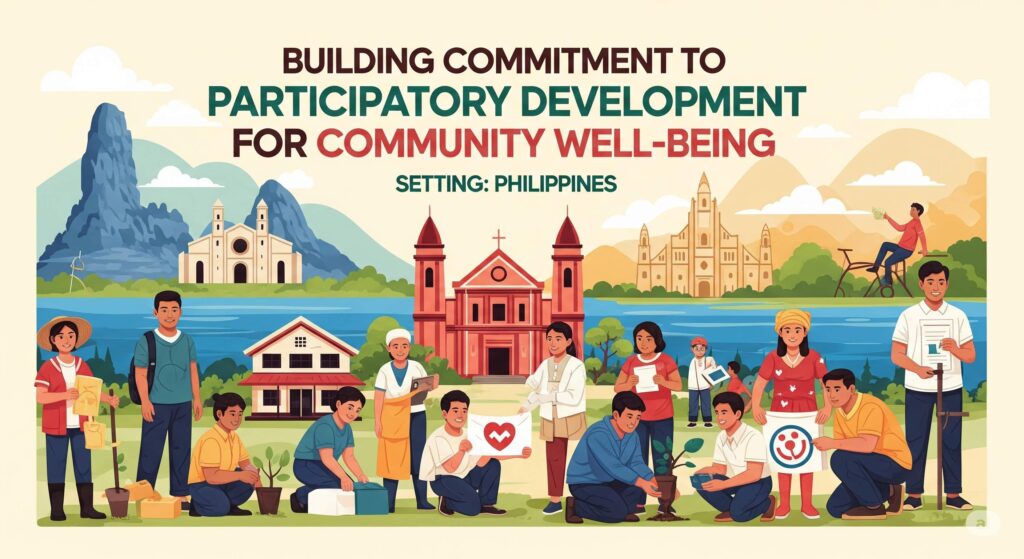Hey, community builder! Let’s explore how to create lasting commitment to participatory development—where everyone works together for a healthier, happier community. Think of it as planting a tree: it takes time, care, and teamwork to grow! 🌱
Step 1: Icebreaker – Your Vision
🎨 Quick Imagine:
If your community were thriving in 10 years, what would it look like?
(Example: “Clean streets, free healthcare, kids laughing in parks!”)
Step 2: What Is Participatory Development?
💡 Definition:
Development by the community, for the community. No more top-down “experts” deciding for people!
🌟 Key Principles:
- Inclusivity : Everyone’s voice matters—youth, elders, marginalized groups.
- Transparency : No hidden agendas! Share budgets, plans, and progress.
- Ownership : The community leads, not just follows.
🌍 Example:
In Nepal, villagers designed their own irrigation systems—resulting in better crop yields and unity.
Step 3: Why Commitment Matters
⚠️ Without Commitment:
- Projects fail when funders leave.
- People lose trust if decisions feel forced.
- Marginalized groups stay sidelined.
🌟 With Commitment:
- Sustainable change (e.g., Rwanda’s community-led healthcare).
- Stronger relationships and trust.
- Creative solutions from diverse perspectives.
Step 4: Strategies to Build Commitment
1. Start with Dialogue
- How : Host town halls, focus groups, or “listening circles.”
- Ask : “What matters most to you? What’s working? What’s broken?”
💡 Activity:
Pair up and brainstorm 3 ways to make your school/community better. Share ideas with the group!
2. Educate & Inspire
- Workshops : Teach participatory budgeting or conflict resolution.
- Stories : Share success stories (e.g., Kerala’s People’s Campaign in India).
📱 Pro Tip:
Use TikTok/Instagram Reels to show how participation transformed other communities.
3. Create Inclusive Spaces
- Language : Use local dialects, not just English.
- Accessibility : Ensure meetings are wheelchair-friendly and childcare is available.
🌍 Example:
In Peru, Indigenous women led protests against mining after organizers provided childcare.
4. Share Power
- Delegate Roles : Let community members lead meetings or manage funds.
- Transparent Decisions : Use voting or consensus to decide priorities.
⚖️ Case Study:
Brazil’s “Participatory Budgeting” lets citizens vote on how to spend 20% of city budgets.
5. Celebrate Small Wins
- Host Block Parties : Celebrate new playgrounds or clean water projects.
- Shout-Outs : Highlight volunteers on social media or community boards.
🎉 Example:
A barangay in Quezon City holds “Gratitude Nights” to honor volunteers.
Step 5: Overcome Challenges
⚠️ Common Hurdles:
- Distrust : “They’ll just take our ideas and ignore us.”
- Burnout : Too many meetings, not enough action.
- Power Struggles : Leaders resisting shared control.
💡 Solutions:
- Build Trust : Start with small projects (e.g., a community garden) to prove commitment.
- Stay Action-Oriented : Turn ideas into quick wins to maintain momentum.
- Negotiate : Involve leaders early to avoid clashes.
Step 6: Case Study – Kerala’s Health Revolution
🌍 How They Did It:
- Problem : High infant mortality.
- Action : Trained local women as health volunteers; held community meetings to design solutions.
- Result : Kerala now has India’s lowest infant mortality rate—thanks to participatory healthcare!
❓ Reflect:
How could your community copy Kerala’s success?
Step 7: Your Commitment Pledge
🚀 Take Action:
- Today : Ask one neighbor, “What’s one thing you’d improve here?”
- This Month : Join or start a participatory project (e.g., mural painting, tree planting).
- Long-Term : Advocate for inclusive policies in schools or local government.
💬 Final Thought:
“Alone we can do so little; together we can do so much.” – Helen Keller
You’re now ready to grow participatory development in your community! Remember: commitment starts with listening, sharing power, and celebrating every step forward. Questions? I’m here! 😊


